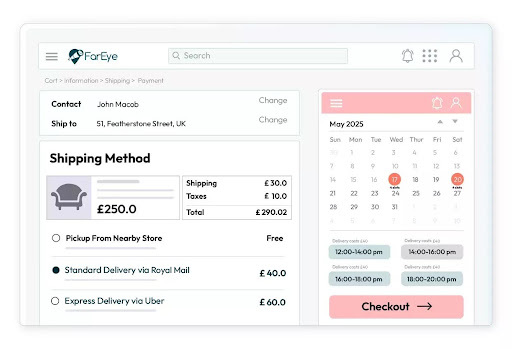- Big & Bulky
The True Cost of Delivery Failures and Reattempts for Big and Bulky Deliveries
Table of Contents
- What Makes Big and Bulky Delivery Unique?
- A Shifting Landscape: US Consumers and the Big and Bulky Delivery Challenge
- Why Delivery Failures Carry Outsized Costs in Big and Bulky Logistics
- What Big and Bulky Routing Software Must Solve
- From Pain to Opportunity: The FarEye Advantage
- Looking Ahead: Transforming the US Big and Bulky Delivery
- FAQ

Every week, thousands of Americans wait for a much-anticipated delivery, whether it’s a mattress, a new washer-dryer, or the dining table that completes their home. For businesses, handling these big and bulky delivery shipments is the moment where promises meet reality. Yet, the industry’s pain points have never been sharper.
The US big and bulky delivery market is under more pressure than ever. According to a report, the American home furnishings sector is experiencing robust growth, expanding at a compound annual growth rate (CAGR) of over 9.2%.
But this surge in volume is paired with sky-high expectations: today’s customer wants precision slot booking, real-time ETAs, the ability to reschedule, and flawless installation, all with minimal hassle. For logistics professionals, every failed big and bulky delivery or reattempt is not just a cost; it’s a setback with real financial, operational, and reputational consequences.

What Makes Big and Bulky Delivery Unique?
Big and bulky deliveries aren’t like standard parcel shipping. Each order involves careful planning, special handling, and close coordination across multiple teams. White-glove delivery for a new couch or a heavy refrigerator can mean two-person crews, equipment for safe lifting, building access permissions and precise installation or removal, plus extra insurance for high-value shipments.
When you miss a slot, everything is impacted: operational costs, customer schedules, and even sustainability targets.
A Shifting Landscape: US Consumers and the Big and Bulky Delivery Challenge
Big and bulky routing is one of the most complex puzzles in the American supply chain. The following pain points are front and center:
- Labor Shortages and Resource Mismatch
Finding enough skilled two-person crews, especially for white-glove delivery and installation services, remains a persistent challenge. With labor costs rising and worker shortages affecting most US metros, every failed attempt wastes not just money but scarce human resources. - Last-mile Congestion and Regulatory Hurdles
Major US cities are tightening access for large vehicles, adding compliance hurdles. Weight restrictions, time-of-day regulations, and parking limitations make heavy‑goods logistics route planning a high-stakes exercise. Miss one detail and deliveries are delayed or rejected at the curb. - Capacity Planning and Asset Utilization
Demand surges unpredictably. Traditional route planning tools often can’t flex with same-day slot changes, customer cancellations, or spikes in returns. The result: partially filled trucks on the road, high per-order costs, and lost revenue opportunities. - Returns and Reverse Logistics Spiraling
The average US return rate for large online orders now exceeds 17%, which is higher, on average, than their annual return rate. Each high‑value shipment return involves repacking, extra handling, and sometimes a separate two-person crew for pickup, ballooning costs, and stretching warehouse space. - Customer Experience Gaps
US consumers expect seamless digital experiences. Any failure in providing real-time tracking, proactive notifications, or transparent rescheduling erodes trust. Worse, many brands still rely on manual calls or emails for updates, leaving customers in the dark and increasing “where is my order” calls. - Sustainability Pressure
Fleet emissions and empty miles are under increasing scrutiny, both from government regulation and consumer values. Failed deliveries mean more trips and higher carbon footprints, a reputational and financial risk, as green delivery windows become a deciding factor for many shoppers.
Why Delivery Failures Carry Outsized Costs in Big and Bulky Logistics
Every failed attempt in heavy‑goods logistics is more expensive, more disruptive, and more visible to the customer than in standard parcel delivery. The true cost includes:
- Direct Financial Impact
- Extra truck rolls, often with a two-person crew, drive up fuel and labor costs.
- Slot Waste: Once a crew is booked for a failed attempt, that capacity cannot be monetized elsewhere that day.
- Reverse Logistics: Each return adds repacking, extra handling and another crew, increasing costs.
- Hidden Operational Losses
- Wasted warehouse labor and cross-dock capacity as items are cycled in and out.
- Scheduling Chaos: Missed high‑value shipments can trigger rescheduling headaches for dispatchers and crews, compounding inefficiency across multiple days.
- Increased call center load as customers seek answers or reschedule themselves.
- Reputational and Brand Harm
- Missed windows are instantly broadcast on social media and review sites.
- Poor NPS scores lead to reduced repeat business, especially as more Americans use online reviews to select retailers.
- Disappointed customers are less likely to opt for additional services such as installation, harming upsell potential.
What Big and Bulky Routing Software Must Solve
Modern challenges in high‑value shipments require a new approach. Standard route planners simply cannot handle the living, breathing nature of US big and bulky logistics. The industry now demands:
- Offer AI‑based Slot Booking and Rescheduling
FarEye’s AI-powered system analyzes historical demand, monitors live traffic, and checks crew availability to offer customers the best available delivery slots and reduce the risk of failed attempts. Customers can reschedule digitally, reducing manual intervention and improving success rates. - Match Orders to Crews by Skill and Asset Requirements
Matching each order to a crew with the right skills (e.g., assembly, installation) and ensuring the right vehicle is assigned reduces the risk of on-site failure due to missing expertise or equipment. - Send Proactive Customer Notifications
Automated, real-time notifications before and during delivery set expectations and reduce the “WISMO” (Where is My Order) call burden. FarEye’s machine learning engine predicts potential delays and triggers alerts, allowing teams to intervene before failures occur. - Support Hybrid Fleet and Sustainability Targets
With a mix of owned, outsourced, and crowd-sourced fleets, big and bulky delivery software helps enterprises dynamically allocate the right resource for each order, considering cost, service, and emissions. - Centralize Control Tower Visibility and Exception Handling
A real-time dashboard gives dispatchers a single view of every asset, order, and route. If a delay or compliance issue arises, exception alerts allow a quick, targeted response before it affects the customer.
From Pain to Opportunity: The FarEye Advantage
FarEye addresses the modern US big and bulky landscape with a purpose-built solution. Our AI-based platform integrates seamlessly with existing OMS, WMS, and TMS solutions, unifying first, middle, and final-mile logistics.
Features like predictive ETA, skill-based routing, returns automation, and branded digital experiences are redefining what’s possible.
Results leading enterprises are achieving:
- 22% increase in first-attempt delivery rates, fewer expensive reattempts.
- 24% boost in on-time delivery, even in metro congestion.
- 97% reduction in ETA windows from days to hours, driving up NPS.
- 30%+ improvement in dispatcher efficiency, more deliveries with less manual work.
Looking Ahead: Transforming the US Big and Bulky Delivery
The story of big and bulky delivery in America is still being written. Customer expectations will only rise, as will regulatory and sustainability pressures. The difference between brands that lead and those that lag will be the ability to deliver literally on every promise made at checkout.
The true cost of delivery failures and reattempts is far higher than it appears in any budget spreadsheet. The future belongs to those who turn pain points into opportunities by leveraging intelligent, customer-centric, and data-driven routing platforms. FarEye helps US enterprises stay ahead in this race, one successful delivery at a time.
Ready to improve your big and bulky delivery? Book a free demo today.
FAQ
How quickly can I implement AI slot booking?
Many teams are live in four to six weeks, with support for API and legacy integrations.
Can this system automate returns?
Yes. FarEye automates the entire returns workflow, from scheduling to restocking, reducing manual handling and improving customer experience.
How can you improve big and bulky delivery without extra cost?
You can improve big and bulky delivery without extra cost by adopting AI-driven slot booking, skill-based crew assignment, and automated customer notifications. These tools optimize routes, reduce failed attempts, and increase first-attempt success using your existing resources, with no need for extra spending.
https://www.grandviewresearch.com/industry-analysis/home-furnishing-market-report

Komal Puri is a seasoned professional in the logistics and supply chain industry. As the AVP of Marketing and a subject matter expert at FarEye, she has been instrumental in shaping the industry narrative for the past decade. Her expertise and insights have earned her numerous awards and recognition. Komal’s writings reflect her deep understanding of the industry, offering valuable insights and thought leadership.
Let's Talk to Our Experts and Optimize Your Deliveries Today!
An expert from our team will reach out within 24 hours
Related resources


